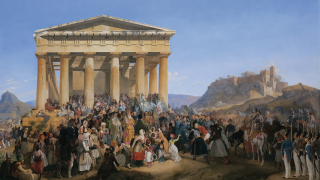The first important confrontation of the campaign Alexander the Great to conquer Persia occurred in the spring of 334 BC in the Granicus Rivernorthwest of modern Türkiye. Although the Achaemenids, led by several satraps from the region and a Greek mercenary, had a significant numerical advantage and had deployed in favorable terrain, the daring Macedonian king did not want to listen to the advice of his general. Parmenium and decided to attack, declaring that he would feel ashamed to stop at that “insignificant stream” after having crossed the Dardanelles.
The battle was fierce and confusingwith groups of mixed riders and disorderly formations. But finally the Macedonian cavalry, more aggressive and with longer spears, managed to climb the sloping bank at the other end of the river and reach the plain where more enemy squadrons were waiting. Alexander, in command of the heterosexualhis elite of mounted warriors, also entered combat and charged against a populated sector of the Persian troops.
According to ancient sources, the legendary conqueror killed a couple of enemy officers: Mithridates, who was married to a daughter from the first marriage of the Persian monarch Darius, and Resaces, brother of the satrap of Lydia and Ionia, who managed to hit Alexander on the helmet with his sword or axe, tearing off one of his characteristic white feathers. In the chaos of the fighting, Black Cleitus, the commander of the royal squadron, managed to save the life of his king when another enemy was about to stab him with his sword.
Detail of Alexander the Great in the mosaic depicting the Battle of Issos
Wikimedia Commons
“That of Granicus was a small battle compared to the great encounters with Darius in the years to come,” explains historian Adrian Goldsworthy in his work Philip and Alexander (The Sphere of Books). “It was not tactically subtle. Alexander needed to fight, he did not want to wait and risk the enemy retreating to another, perhaps better, position, and he trusted in the skill and ferocity of his men (…) It was a gamble, and if Cleitus had been slower, the king could well have been killed and the campaign would have failed right there. Luck and skill were with the Macedonians and the bet was a winner.”
The site of the clash between the Macedonian and Persian armies has been identified about 10 kilometers north of the modern Turkish town of Biga thanks to a research project spanning more than two decades led by Reyhan Körpe, professor in the Department of History at Canakkale Onsekiz Mart University. Although this is not a new location hypothesis, his team has managed to collect a series of evidence that now allows it to be confirmed.

human bones
“After almost 150 years of searching, we have located the route that Alexander followed and that led to the Battle of Granicus. Our research, combined with a careful reading of ancient sources, has led us to determine the exact location of the battle, the towns involved and their position within the plains,” said the historian, according to Türkiye Today.
Archaeologists have documented the remains of an ancient settlement supposedly used by Alexander the Great as a last camp before battle. A proposal has also been made about the hill behind the river on which Memnon of Rhodes’ Greek mercenaries serving the Achaemenid Empire were deployed. It is a place where local farmers have uncovered human remains mixed with ancient period weapons.
Cleitus the Black saves Alexander’s life.
“The lack of tombstones or typical artifacts indicates that they were not part of a formal cemetery,” Körpe revealed to the portal. LiveScience on the bones of an adult male found this year during the plowing of the land. Analysis in the laboratory will try to identify his chronology and the cause of his death.
Researchers have also carried out geomorphological studies to reconstruct the landscape of the area at the time of the battle, in 334 BC. Although the riverbed was believed to have been altered by agricultural irrigation systems and centuries of flood control, Körpe’s team points out that the course of the Granico has changed little since the 4th century BC These results have allowed them to rule out other proposals for crash sites since in Alexander’s time they were swampy areas.
The historian has explained that the project, supported by the Turkish Ministry of Culture, continues its course and that they plan to carry out geophysical surveys and excavations to know the secrets hidden beneath the ground. The identification of the routes followed by Alexander’s troops will also be highlighted as a cultural route for tourists.
The post They identify the lost scene of a crucial battle between Alexander the Great and the Persians appeared first on Veritas News.
